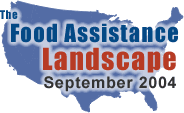|
|
||
| food
and nutrition assistance program operations and integrity |
||
|
overview features Plate Waste in School Nutrition Programs: Final Report to Congress—This Congressionally mandated study reviews existing information on the level of plate waste in the National School Lunch Program (NSLP) and assesses strategies to reduce it. The best national estimate available indicates that about 12 percent of calories from food served to students under the NSLP go uneaten. Although some plate waste is inevitable, introducing measures to reduce plate waste could make program operations more efficient and lower costs. Possible strategies include allowing students to select components of their meal, rescheduling lunch hours, improving the quality and condition of food, tailoring serving sizes to student appetites via self-service, and providing nutrition education. Methods to Prevent Fraud and Abuse Among Staff and Participants in the WIC Program: Volume I, Final Report—This report identifies and assesses methods used to detect and prevent fraud and abuse among staff and participants of the WIC program. The study identifies a framework for identifying vulnerabilities and options for addressing them. The structure of the State's management information system was singled out as a particularly important factor in shaping the options for fraud prevention and detection. recommended readings Re-Engineering the Welfare System-A Study of Administrative Changes to the Food Stamp Program: Final Report—This report presents the findings of a survey of State food stamp administrators to determine the types of activities undertaken to "re-engineer" State Food Stamp Program operations as a result of legislative changes of the 1996 welfare reform law. The most frequently reported changes were those of client tracking, accountability, and certification systems. The next most frequently reported change was to conform FSP and Temporary Assistance to Families with Needy Children (TANF) rules. State Use of Funds To Increase Work Slots for Food Stamp Recipients: Report to Congress—This Congressionally mandated report examines States' use of new Food Stamp Employment and Training (E&T) Program funds authorized by the 1997 Balanced Budget Act. The results show that total E&T Program spending increased, although States used less of their Federal grant allocations and more of State matching funds. The study includes specific recommendations for improving the E&T Program. recommended data products FANRP Project Database—Provides details on FANRP research projects, both past and ongoing, including the project's objective, funding level, researchers, and expected completion date. See projects classified under program operations and program integrity. County and State program funds data—ERS provides data on per capita Federal funding for all Federal programs for which we have accurate county level data, and for the various functional and object categories of Federal programs. For more information and access to the data for fiscal 1994-2000, see the Federal Funds briefing room. recent research developments newsletters related links Office of the Inspector General—Investigates allegations of fraud and abuse associated with USDA programs and engages in activities to promote the operational efficiency and protect integrity of all programs. Audit reports for programs operated by the Food and Nutrition Service released since 1998 can be accessed online. United States General Accounting Office (GAO)—GAO frequently conducts studies related to food assistance program operations and integrity. Reports released since 1997 are available online. images gallery Food and nutrition assistance programs at a glance—Charts, tables, and data on food stamps, WIC, child nutrition programs, and more.
for more information, contact:
Alex Majchrowicz
|
|
|
|
USDA / FedStats / accessibility / privacy policy / contact us / advanced search / site map |
 For USDA's
For USDA's 